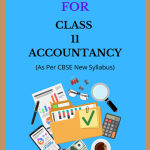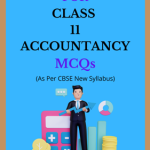NCERT Class 11 Accountancy MCQ Chapter 2 Theory base of Accounting Solutions, AHSEC Class 11 Accountancy Multiple Choice Question Answer to each chapter is provided in the list so that you can easily browse throughout different chapters NCERT Class 11 Accountancy MCQ Chapter 2 Theory base of Accounting Question Answer and select needs one.
NCERT Class 11 Accountancy MCQ Chapter 2 Theory base of Accounting
Also, you can read the AHSEC book online in these sections NCERT Class 11 Accountancy Multiple Choice Solutions by Expert Teachers as per AHSEC (CBSE) Book guidelines. AHSEC Class 11 Accountancy MCQ Solutions. These solutions are part of AHSEC All Subject Solutions. Here we have given HS 1st Year Accountancy Objective Type Question Answer for All Subjects, You can practice these here.
Theory base of Accounting
Chapter: 2
| PART – Ⅰ |
MULTIPLE CHOICE QUESTION ANSWER
1. The sum of Liabilities and Capital is-
(i) Expense.
(ii) Income.
(iii) Drawings.
(iv) Assets.
Ans: (iv) Assets.
2. What does GAAP stand for?
(i) General Accounting and Auditing Procedures.
(ii) Generally Accepted Accounting Principles.
(iii) Governmental Accounting and Auditing Policies.
(iv) Generally Accepted Accounting Procedures.
Ans: (ii) Generally Accepted Accounting Principles.
3. What is the main purpose of GAAP?
(i) To confuse users of financial statements.
(ii) To bring uniformity in the preparation and presentation of
financial statements.
(iii) To allow for personal interpretations of accounting.
(iv) To provide guidelines for personal budgeting.
Ans: (ii) To bring uniformity in the preparation and presentation of financial statements.
4. In India, the accounting standard board was set up in the year-
(i) 1972.
(ii) 1977.
(iii) 1956.
(iv) 1932.
Ans: (ii) 1977.
5. The amount drawn by businessmen for his personal use is-
(i) Capital.
(ii) Drawing.
(iii) Expenditure.
(iv) Loss.
Ans: (iv) Loss.
6. Which of the following concepts asserts that a business is separate from its owners?
(i) Going Concern.
(ii) Business Entity.
(iii) Dual Aspect.
(iv) Materiality.
Ans: (ii) Business Entity.
7. According to the Business Entity concept, which of the following is true?
(i) Personal assets and liabilities of the owner are included in the business’s records.
(ii) Business transactions are recorded from the owner’s perspective.
(iii) Personal transactions of the owner are not recorded in the business’s books.
(iv) The owner has no legal claim over the business.
Ans: (iii) Personal transactions of the owner are not recorded in the business’s books.
8. When an owner invests money into their business, how is it recorded in accounting?
(i) As an expense of the business.
(ii) As a revenue for the business.
(iii) As a liability of the business to the owner.
(iv) As a profit of the business.
Ans: (iii) As a liability of the business to the owner.
9. Which of the following transactions would be recorded under the Money Measurement concept?
(i) The appointment of a new manager.
(ii) The company’s reputation among customers.
(iii) Sale of goods for cash.
(iv) The creativity of the research department.
Ans: (ii) The company’s reputation among customers.
10. The sum of Liabilities and Capital is-
(i) Expense.
(ii) Income.
(iii) Drawings.
(iv) Assets.
Ans: (iv) Assets.
11. In India, the accounting standard board was set up in the year-
(i) 1972
(ii) 1977
(iii) 1956
(iv) 1932.
Ans: (ii) 1977
12. If a computer is purchased for Rs. 50,000 with an estimated life of 5 years, how much should be charged to the profit and loss account each year?
(i) 50,000
(ii) 5,000
(iii) 10,000
(iv) 15,000
Ans: (iii) 10,000
13. Meaning of credibility of going concern is:
(i) Closing of business.
(ii) Opening of business.
(iii) Continuing of business.
(iv) None of these.
Ans: (iii) Continuing of business.
14. A company has a beginning inventory of Rs.20,000, purchases of Rs.80,000, and an ending inventory of Rs.30,000. What is the cost of goods sold (COGS)?
(i) Rs.70,000
(ii) Rs.80,000
(iii) Rs.30,000
(iv) Rs.90,000
Ans: (i) Rs.70,000
15. Which companies are required to publish quarterly financial results?
(i) Private limited companies.
(ii) Sole proprietorships.
(iii) Companies listed on the stock exchange.
(iv) Small businesses.
Ans: (iii) Companies listed on the stock exchange.

Hi! my Name is Parimal Roy. I have completed my Bachelor’s degree in Philosophy (B.A.) from Silapathar General College. Currently, I am working as an HR Manager at Dev Library. It is a website that provides study materials for students from Class 3 to 12, including SCERT and NCERT notes. It also offers resources for BA, B.Com, B.Sc, and Computer Science, along with postgraduate notes. Besides study materials, the website has novels, eBooks, health and finance articles, biographies, quotes, and more.





